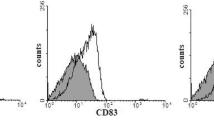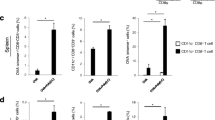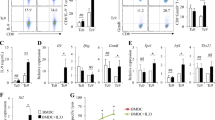Abstract
Dendritic cell (DC) vaccines offer a robust platform for the development of cancer vaccines, but their effectiveness is thought to be limited by T regulatory cells (Tregs). Recombinant adenoviruses (RAdV) have been used successfully to engineer tumor antigen expression in DCs, but the impact of virus transduction on susceptibility to suppression by Tregs is unknown. We investigated the functional consequences of exposure to adenovirus on interactions between human monocyte-derived DCs and Tregs. Since the development of Tregs is linked to that of pro-inflammatory Th17 cells, the role of Th17 cells and IL-17-producing Tregs in the context of DC-based immunotherapies was also investigated. We found that Tregs potently suppressed the co-stimulatory capacity of RAdV-transduced DCs, regardless of whether the DCs were maturated by inflammatory cytokines or by exposure to Th1 or Th17 cells. Furthermore, exposure of Tregs to RAdV-exposed DCs increased IL-17 production and suppressive capacity, and correlated with enhanced secretion of IL-1β and IL-6 by DCs. The findings that DCs exposed to RAdV are suppressed by Tregs, promote Treg plasticity, and enhance Treg suppression indicates that strategies to limit Tregs will be required to enhance the efficacy of such DC-based immunotherapies.





Similar content being viewed by others
References
Scheid E, Ricci M, Foley M (2010) Dendritic cell based cancer vaccines: practical considerations. In: Medin J, Fowler D (eds) Experimental and applied immunotherapy, Humana Press, pp 107–126
Nayak S, Herzog RW (2009) Progress and prospects: immune responses to viral vectors. Gene Ther 20:203–301
Fontana R et al (2009) Peripheral blood lymphocytes genetically modified to express the self/tumor antigen MAGE-A3 induce antitumor immune responses in cancer patients. Blood 113:1651–1660
Nakamura M et al (2005) Dendritic cells transduced with tumor-associated antigen gene elicit potent therapeutic antitumor immunity: comparison with immunodominant peptide-pulsed DCs. Oncology 68:163–170
Butterfield LH et al (2008) Adenovirus MART-1-engineered autologous dendritic cell vaccine for metastatic melanoma. J Immunother 31:294–309
Tsao H et al (2002) Hypopigmentation associated with an adenovirus-mediated gp100/MART-1-transduced dendritic cell vaccine for metastatic melanoma. Arch Dermatol 138:799–802
Whiteside TL (2010) Inhibiting the inhibitors: evaluating agents targeting cancer immunosuppression. Expert Opin Biol Ther 10(7):1019–1035
Zou W (2006) Regulatory T cells, tumour immunity and immunotherapy. Nat Rev Immunol 6:295–307
Dunn GP, Old LJ, Schreiber RD (2004) The immunobiology of cancer immunosurveillance and immunoediting. Immunity 21:137–148
Sakaguchi S (2005) Naturally arising Foxp3-expressing CD25+CD4+ regulatory T cells in immunological tolerance to self and non-self. Nat Immunol 6:345–352
Vignali DA, Collison LW, Workman CJ (2008) How regulatory T cells work. Nat Rev Immunol 8:523–532
Bayry J, Triebel F, Kaveri SV, Tough DF (2007) Human dendritic cells acquire a semimature phenotype and lymph node homing potential through interaction with CD4+CD25+ regulatory T cells. J Immunol 178:4184–4193
Onishi Y, Fehervari Z, Yamaguchi T, Sakaguchi S (2008) Foxp3+ natural regulatory T cells preferentially form aggregates on dendritic cells in vitro and actively inhibit their maturation. Proc Natl Acad Sci USA 105:10113–10118
Liang B et al (2008) Regulatory T cells inhibit dendritic cells by lymphocyte activation gene-3 engagement of MHC class II. J Immunol 180:5916–5926
Amarnath S et al (2010) Regulatory T cells and human myeloid dendritic cells promote tolerance via programmed death ligand-1. PLoS Biol 8:e1000302
Benchetrit F et al (2002) Interleukin-17 inhibits tumor cell growth by means of a T-cell-dependent mechanism. Blood 99:2114–2121
Murugaiyan G, Saha B (2009) Protumor vs. antitumor functions of IL-17. J Immunol 183:4169–4175
Weaver CT, Hatton RD (2009) Interplay between the TH17 and TReg cell lineages: a (co-)evolutionary perspective. Nat Rev Immunol 9:883–889
Koenen HJ, Smeets RL, Vink PM, van Rijssen E, Boots AM, Joosten I (2008) Human CD25highFoxp3pos regulatory T cells differentiate into IL-17-producing cells. Blood 112:2340–2352
Voo KS et al (2009) Identification of IL-17-producing FOXP3+ regulatory T cells in humans. Proc Natl Acad Sci USA 106:4793–4798
Miyara M, Sakaguchi S (2007) Natural regulatory T cells: mechanisms of suppression. Trends Mol Med 13:108–116
Adema GJ (2009) Dendritic cells from bench to bedside and back. Immunol Lett 122:128–130
Jenne L, Schuler G, Steinkasserer A (2001) Viral vectors for dendritic cell-based immunotherapy. Trends Immunol 22:102–107
Zhong L, Granelli-Piperno A, Choi Y, Steinman RM (1999) Recombinant adenovirus is an efficient and non-perturbing genetic vector for human dendritic cells. Eur J Immunol 29:964–972
Diao J, Smythe JA, Smyth C, Rowe PB, Alexander IE (1999) Human PBMC-derived dendritic cells transduced with an adenovirus vector induce cytotoxic T-lymphocyte responses against a vector-encoded antigen in vitro. Gene Ther 6:845–853
Crome SQ, Wang AY, Kang CY, Levings MK (2009) The role of retinoic acid-related orphan receptor variant 2 and IL-17 in the development and function of human CD4+ T cells. Eur J Immunol 39:1480–1493
Antonysamy MA et al (1999) Evidence for a role of IL-17 in organ allograft rejection: IL-17 promotes the functional differentiation of dendritic cell progenitors. J Immunol 162:577–584
Pan J et al (2004) Interferon-gamma is an autocrine mediator for dendritic cell maturation. Immunol Lett 94:141–151
Wilson NJ et al (2007) Development, cytokine profile and function of human interleukin 17-producing helper T cells. Nat Immunol 8:950–957
Annunziato F et al (2007) Phenotypic and functional features of human Th17 cells. J Exp Med 204:1849–1861
Awasthi A et al (2009) Cutting edge: IL-23 receptor gfp reporter mice reveal distinct populations of IL-17-producing cells. J Immunol 182:5904–5908
Acosta-Rodriguez EV, Napolitani G, Lanzavecchia A, Sallusto F (2007) Interleukins 1β and 6 but not transforming growth factor-beta are essential for the differentiation of interleukin 17-producing human T helper cells. Nat Immunol 8:942–949
Kelleher P, Knight SC (1998) IL-12 increases CD80 expression and the stimulatory capacity of bone marrow-derived dendritic cells. Int Immunol 10:749–755
Beriou G et al (2009) IL-17-producing human peripheral regulatory T cells retain suppressive function. Blood 113:4240–4249
Lyakh LA, Koski GK, Young HA, Spence SE, Cohen PA, Rice NR (2002) Adenovirus type 5 vectors induce dendritic cell differentiation in human CD14(+) monocytes cultured under serum-free conditions. Blood 99:600–608
Yang XO et al (2007) STAT3 regulates cytokine-mediated generation of inflammatory helper T cells. J Biol Chem 282:9358–9363
de Martel C, Plummer M, Parsonnet J, van Doorn LJ, Franceschi S (2009) Helicobacter species in cancers of the gallbladder and extrahepatic biliary tract. Br J Cancer 100:194–199
Maes W et al (2009) DC vaccination with anti-CD25 treatment leads to long-term immunity against experimental glioma. Neurol Oncol 11:529–542
Ng P, Parks RJ, Cummings DT, Evelegh CM, Graham FL (2000) An enhanced system for construction of adenoviral vectors by the two-plasmid rescue method. Hum Gene Ther 11:693–699
Yang TC et al (2006) The CD8+ T cell population elicited by recombinant adenovirus displays a novel partially exhausted phenotype associated with prolonged antigen presentation that nonetheless provides long-term immunity. J Immunol 176:200–210
Acknowledgments
This work was supported by a Terry Fox Foundation program project grant in cancer immunotherapy awarded to MKL, JAM and JLB. MKL holds a Canada Research Chair in Transplantation. AYW holds a CIHR Canada Graduate Award and a CIHR/SRTC Strategic Training Program in Transplantation award. SQC holds a MSFHR Senior Graduate Studentship award and CIHR/SRTC Strategic Training Programs in Skin and Transplantation awards. Core support for flow cytometry sorting provided by Lixin Xu and was funded by the Immunity and Infection Research Centre MSFHR Research Unit.
Conflict of interest
The authors declare no competing financial interests.
Author information
Authors and Affiliations
Corresponding author
Electronic supplementary material
Below is the link to the electronic supplementary material.
Rights and permissions
About this article
Cite this article
Wang, A.Y., Crome, S.Q., Jenkins, K.M. et al. Adenoviral-transduced dendritic cells are susceptible to suppression by T regulatory cells and promote interleukin 17 production. Cancer Immunol Immunother 60, 381–388 (2011). https://doi.org/10.1007/s00262-010-0948-4
Received:
Accepted:
Published:
Issue Date:
DOI: https://doi.org/10.1007/s00262-010-0948-4




